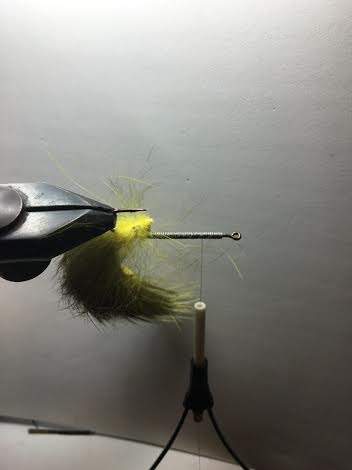By: Levi Opsatnic
If you’re a fly angler in Pennsylvania, the fall season probably means one thing, and that’s chasing large brown trout. The amount of daylight is thinning, winter is approaching, I’ve already seen signs of spawning on some stream, and the trout (especially the large ones) are bulking up before they seek refuge for the cold winter months.
I’ve found that for the next month or so, the larger fish are on the move and are looking to really fill their bellies. This is a perfect time to scout these fish out and taunt them with large, aggressive streamers.
In this post, I’d like to show you all one of my favorite fall streamers. This fly is responsible for more of my large trout caught in the autumn than any other fly. Whether your pursuits are nocturnal or just in high water, this fly is sure to at least get the attention of a lunker.
Material:
Hook: Any streamer hook between the sizes of 1/0-8. For the sake of this fly, I’m using a size 1 Mustad hook.
Thread: 6/0 black Uni-Thread.
Weight: .020 lead free wire.
Head: Medium Scuplin Helmet
Tail: Olive Zonker strip with a couple strands of olive Krystal Flash.
Body: Olive marabou.
Fins: Olive marabou.
Step 1
Begin by wrapping your hook shank with lead. I like to leave some room in the rear and head for finishing the fly and tying in a tail.
Step 2
Remove your hook from the vise and strip off the end of an inch or so long piece of Zonker strip. Now that you have piece of the Zonker that’s free of fur, puncture it through the hook and orient it in the tail position. Tie in your tail and a couple strands of Krystal Flash on either side. After this step, I also like to coat my wire in Super Glue and let it dry.
Step 3
Tie in your marabou by the tip as well as a piece of silver wire for ribbing. Wrap the marabou about 2/3 of the way up the hook shank and rib the body with your wire.
Step 4
Tie in the tip of a marabou feather on either side of your fly to represent the front fins of the sculpin. These fins should be about 1/3 of your body.
Step 5
Build up some thread on the remainder of your hook shank. Now use a liberal amount of Super Glue to coat the head of your fly in preparation for attaching the sculpin head. After there’s enough Super Glue on, apply your Scuplin and let it dry.
This fly may not be the prettiest in your box. However, it is extremely effective, and it also rides with its hook up so snags are less of a hassle. I like to fish this fly by letting it slowly drift downstream and then slowly retrieving it upstream. I see a lot of anglers retrieving their streamers by ripping them through every inch of water at speeds upwards of 30 mph. I like to take a slower approach. After all, have you ever seen a minnow quickly swim up and down the stream? Probably not, as most minnows (especially sculpins) like to swim a little, take cover, and station themselves in one area. I like to think that mimicking this sort of behavior leads to a little more success.










Pingback: /Explore | Preparation for the Steelhead Season